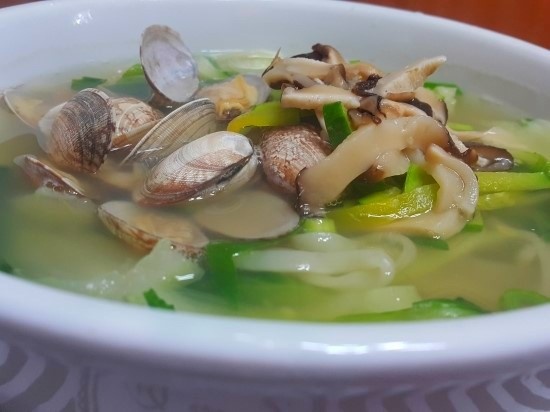Refreshing Clam Noodle Soup (Bajirak Kalguksu) with Well-Purged Clams and Fresh Vegetables
A Delicious Bajirak Kalguksu Recipe with Bok Choy and Zucchini for a Richer Flavor

Bajirak Kalguksu, or Korean clam noodle soup, is a beloved classic. Its refreshing and deep broth, made with plenty of fresh clams, is truly satisfying. This recipe enhances the dish by adding bok choy for a crisp texture and zucchini for a touch of sweetness. A small amount of young cabbage can also be a delightful addition. From the Dr. Saeng Fruit Juice blog, this recipe will guide you in making restaurant-quality kalguksu at home. (Blog: http://blog.naver.com/misorang2)
Main Ingredients- 4 servings store-bought Kalguksu noodles
- 3000 won worth of fresh clams (approx. 300g)
- 4 heads of Bok Choy
- 1/2 Zucchini
Broth Ingredients- Approx. 30-40 Dried Anchovies for broth
- 2 Dried Shiitake Mushrooms
- 1/2 Onion
- 4 Dried Pollock Heads (optional, can substitute with a little dried pollack)
- 2-3 pieces Dried Kelp
- 1 Tbsp Salted Shrimp
- 4-5 bowls of Water (approx. 2L)
- Approx. 30-40 Dried Anchovies for broth
- 2 Dried Shiitake Mushrooms
- 1/2 Onion
- 4 Dried Pollock Heads (optional, can substitute with a little dried pollack)
- 2-3 pieces Dried Kelp
- 1 Tbsp Salted Shrimp
- 4-5 bowls of Water (approx. 2L)
Cooking Instructions
Step 1
For a deep and refreshing broth, prepare the dried anchovies, dried shiitake mushrooms, onion, dried pollock heads (if using), and kelp. In a large pot, pour in 4-5 bowls of water (about 2L) and add all these ingredients.

Step 2
Once the broth begins to boil, add 1 tablespoon of salted shrimp to enhance its rich umami flavor.

Step 3
Properly purging the clams is crucial. Place the clams in a bowl, dissolve 2 tablespoons of coarse salt in water, and add enough water to cover the clams. Let them purge in this saltwater for 1-2 hours.

Step 4
After purging, rinse the clams thoroughly under running water to remove any sand or debris attached to their shells.

Step 5
Store-bought kalguksu noodles can sometimes have a distinct smell, so we will boil them separately later. (This smell can occur during storage.)

Step 6
Wash the zucchini, remove the seeds, and thinly julienne it. Prepare it for cooking.

Step 7
Wash the bok choy under running water. Trim the root ends, separate the leaves from the stems, and cut the stems into 2-3 lengthwise pieces. The leaves can be left whole.

Step 8
You can add the tougher stems or leaves of the bok choy that are trimmed off into the broth while it’s simmering. This will add more vegetable flavor. (Optional)

Step 9
Add the leftover bok choy trimmings to the broth while it’s simmering. This helps to create a more concentrated vegetable stock.

Step 10
After simmering the broth for about 30 minutes, turn off the heat and strain out all the solid ingredients (anchovies, shiitake mushrooms, onion, etc.). Ladle about one bowl of the broth into a separate small pot for cooking the clams. This is done to meticulously remove any sand from the clams.

Step 11
Return the main pot with the remaining broth to the stove.

Step 12
Add the purged clams to the separate small pot containing the ladle of broth and cook them.

Step 13
Once the clams start to open, stir them gently 3-4 times and immediately turn off the heat. Overcooking can make the clams tough and the broth cloudy.

Step 14
Remove the cooked clams. Carefully pour the clam cooking liquid (broth) into the main broth pot. This step helps to ensure no fine sand remains in the final soup.

Step 15
Discard any remaining sediment from the pot used to boil the clams.

Step 16
Don’t discard the shiitake mushrooms used for the broth. Retrieve them, rinse them clean.

Step 17
Thinly slice the rinsed shiitake mushrooms into ‘fillets’.

Step 18
Add the thinly sliced shiitake mushrooms to the main broth. Utilizing these precious ingredients not wasted adds a deeper flavor.

Step 19
Add the julienned zucchini to the broth.

Step 20
Simmer the zucchini and prepared bok choy in the broth briefly. Now, add the chopped scallion, minced garlic, and pepper, and season the soup. Use soy sauce for soup and coarse salt to adjust the taste, keeping in mind that the salted shrimp has already added some saltiness. Keep the lid off while simmering to maintain the vibrant green color of the bok choy. (Covering can cause the color to turn yellowish.)

Step 21
In a separate pot, bring plenty of water to a boil for cooking the kalguksu noodles. Boiling the noodles separately is recommended to remove any potential ‘chemical’ smell from the noodles and to achieve the best texture. It’s also a tip often shared on TV that serving the noodles separately from the broth results in a cleaner and tastier soup.

Step 22
Once the noodles are cooked, rinse them under cold water to remove excess starch. Then, arrange one serving of noodles attractively in a ceramic bowl.

Step 23
Arrange a few pieces of the cooked bok choy attractively on top of the noodles.

Step 24
Add a generous portion of the well-cooked clams on top, and ladle the hot, prepared broth generously over the noodles and vegetables.

Step 25
Your delicious Bajirak Kalguksu is now complete! The broth, enhanced by the dried pollock heads, is remarkably clean, refreshing, and deeply flavorful. For an extra touch of aroma, add a drop of sesame oil if desired. Enjoy your meal!




